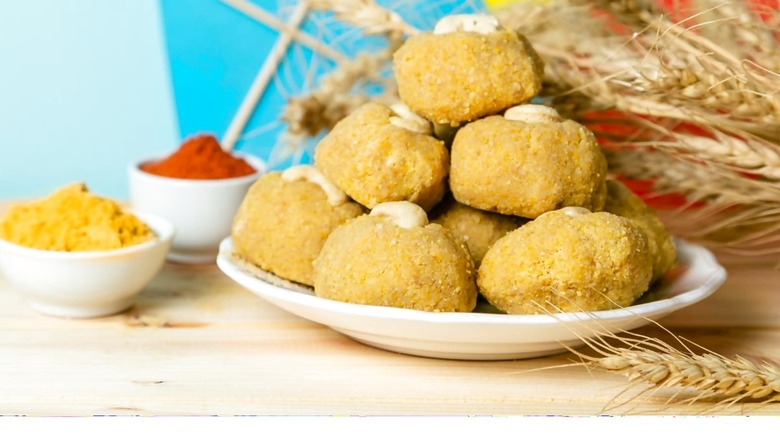
views
It was utter discomposure. Come January, as the festival of Makar Sankranti approached, our kitchen at my grandmother’s house would turn hysterical. There was only one thing on everyone’s mind. “Til gul ghya, ni goad goad bola (तीळ गूळ घ्या नी गोड-गोड बोला), which from Marathi loosely translates as, “eat til and gud, and speak and be well”, but manifests in the hysteria of making of ladoos and chikki of Til and Gud.
The kitchen would be filled with the aromas of golden brown jaggery slowly cooking in iron pots, nutty sesame seeds roasting alongside. Stirring and waiting till that perfect moment, when the jaggery has melted and caramelised, just right, when the toasted sesame would be mixed into that melting sweetness of hot moulten jaggery. Quickly stirring, mixing till consistent and then rolling out hot small ladoos, before the mixture dries and hardens. Your palms getting singed and cauterised in the process, only protected by a little oil that aided in getting those ladoos perfectly round, shiny and as hard as mini golf balls.
Another batch of melted jaggery and sesame poured out into large steel plates, and hurriedly rolled out by a rolling pin, hastily spreading the sweet, sweet lava to make thin layers of sesame chikki. The process would then be repeated replacing sesame seeds with either roasted peanuts, channa, cashews, or amaranth.
By the time January 15 (Sankranti) arrived, there would be large tins full of til ladoos, til and peanut chikki, rajgira chikki, and kurmura / mamra or puffed rice chikki waiting to be eaten and shared. Although a variety of ladoos and chikkis were made, til ladoos were the most auspicious.
In the Indian mythology, til, or sesame seeds are said to be blessed by Yama (God of death) and are consumed as a symbol of immortality. In actuality, sesame is full of the richness of minerals and vitamins, and thought of as a superfood and has been a part of Indian tradition since literally the beginning of time.
The harvest festival of Sankranti in Maharashtra, which coincides with Pongal in the south and comes straight after winter, is celebrated all over the country, although with different names. Like Magh Bihu in Assam, Maghi Saaji in Himachal Pradesh, Lohri in North India, Maghi Sangrand or Uttarayana in Jammu, Uttarayana in Gujarat and Uttar Pradesh, Ghughuti in Uttarakhand, Dahi Chura in Bihar, and Songkran even in Thailand.
In our Maharashtrian household, til laddoos would be not only relished but even distributed to neighbours, visitors, friends and whoever came to the door that day.
Even the menu for Sankranti would be special. Often the meal would be vegetarian, and Bhogichi Bhaji would be cooked. Bhogichi Bhaji is a mixed vegetable curry using seasonal veggies like broad beans (ghevada, flat beans, hyacinth beans), lima beans (pavta, surti papdi), snow peas (val papdi), drumstick, brinjals, fresh green chana and potatoes. The recipe has a slight sour and sweet taste with complex flavours that come from peanuts, sesame, jaggery, asafoetida, and coriander. It’s a bit like an Undhiyu, and goes great with hot chapatis or pooris, or Gulachi poli — sweet roti stuffed with shredded jaggery and ground til cooked in pure ghee.
But there is something about Sankranti and Khichdi. I am sure there is some legend or story, but आपको पेड़ गिनने से मतलब है, या आम खाने से. Urad Dal Khichdi with Kadhi is a staple on the Sankranti Day. Even when you go to south where this harvest season is celebrated as Pongal, you will notice the similarity in the ingredients and staples.
Ven Pongal – a savory dish made of rice and moong dal – is made by cooking rice and moong dal, and then tempered with ghee, cumin seeds, and pepper and is served with sambar and chutney. Then there is Kambu Koozh, which is like a thin porridge made of Bajra, boiled with salt and turmeric, embellished with sour curd green chili, ginger and cumin. It’s a filling, nutritious drink. In sweet, there is Sarkkarai Pongal – made of rice, moong dal, jaggery, and milk. Of course, the most famous Pongal food is Pongal Payasam, a sweet pudding made of rice, jaggery, and milk. Flavoured with cardamom and garnished with cashews, raisins, and dry fruits it’s the food of the Gods.
When I think of our Indian festivals and the food associated with each and every one of them, I realise what a binding force food can be. And with food at the centre of our lives, it just reinforces my sentiment that we are all different, but we are all actually one.
Kunal Vijayakar is a food writer based in Mumbai. He tweets @kunalvijayakar and can be followed on Instagram @kunalvijayakar. His YouTube channel is called Khaane Mein Kya Hai. The views expressed in this article are those of the author and do not represent the stand of this publication.
Read all the Latest Lifestyle News here




















Comments
0 comment